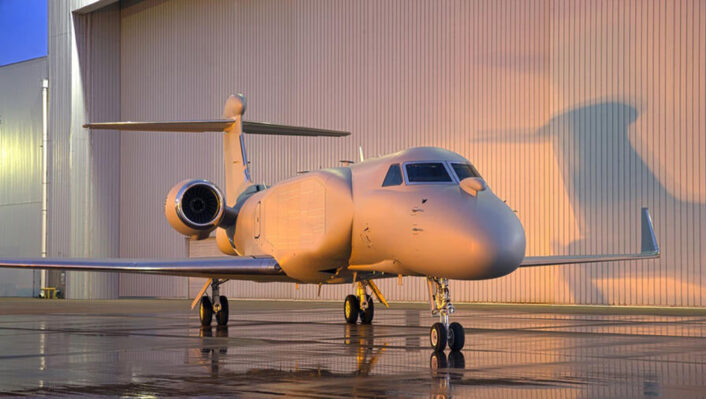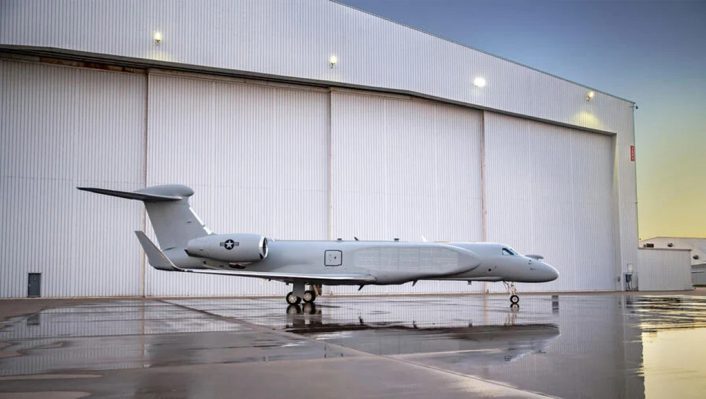[ad_1]

Under the Compass Call Rehost program, the electronic attack mission is transitioning from the EC-130H to the EC-37B, with deliveries slated to begin later this year.
The U.S. Air Force is continuing the works to get its electronic attack capabilities into the future, upgrading and transitioning the Compass Call airborne tactical electronic attack weapon system from the 40 years old EC-130H to the new EC-37B. The aircraft performed its first test flight in the fully missionized configuration and USAF livery on May 4, 2023, from L3Harris’ integration and modification center in Waco, Texas.
L3Harris released a press statement to confirm this first four-hour test flight, before later removing it from its website. The few photos available from the flight and after the aircraft received its new livery were also cleaned of the USAF and unit markings, leaving only the roundels visible. In fact, uncredited sources also posted online the unedited photos, which show also the DM tail flash of the aircraft and it provisional FAA registration, which will be later replaced by the military serial.
Compass Call disrupts enemy command and control communications, radars, and navigation systems and limits adversary coordination, as part of the Counter-Command, Control, Computers, Communications, Cyber, Intelligence, Surveillance and Reconnaissance Targeting (Counter-C5ISRT) mission. Restricting an adversary’s battlespace coordination and force management, as well as suppressing the air defenses, is essential in today’s operational scenarios to improve the chances of missions’ success.
The Compass Call system is one of the busiest assets of the entire US inventory, which took part in every conflict where US troops were engaged in combat, and is also longest continuously deployed Air Force asset, being deployed since 2002 in Afghanistan. Together with the EA-18G Growler and the F-16CM Block 50/52 Fighting Falcon, Compass Call is part of the US Suppression of Enemy Air Defense (SEAD) triad.
The EC-130H is operated by the 55th Electronic Combat Group (ECG) at Davis-Monthan AFB as a geographically separated unit of the 55th Wing based at Offutt AFB, Nebraska. The latter provides Intelligence, Surveillance and Reconnaissance (ISR), Electronic Warfare (EW), Command and Control (C2) and national treaty verification capabilities for the U.S. forces with numerous variants of the C-135 and C-130 airframes. Once delivered, the EC-37Bs will be assigned to the 55th ECG.

The EC-130H flew for the first time in 1981 and was delivered to the Air Force a year later. The aircraft, with a crew of 13 people (four responsible for flight and navigation and nine for the EA mission equipment), has been upgraded throughout the years, but after 40 years it needs a replacement. Following the type’s retirement announced in 2014, the U.S. Air Force initiated the Compass Call Rehost program, which is moving the Compass Call suite from the EC-130H to the new EC-37B, based on the Gulfstream G550 Conformal Airborne Early Warning Aircraft (CAEW) airframe.
As for the EC-130H, BAE Systems is the contractor for the Prime Mission Equipment (PME) and L3 Communications is the contractor for aircraft integration and depot maintenance. L3 Communications and Gulfstream got a sole-source contract in 2017 to start rehosting Compass Call. The companies said the EC-37B will provide significantly improved survivability, as well as improved stand-off jamming capability and flexibility to counter sophisticated communications and radar threats.
The upgrade of the Compass Call mission system involves a number of incremental capabilities, such as BAE Systems’ Small Adaptive Bank of Electronic Resources technology. SABER is a major technological advance that will allow the Compass Call weapon system to transition from hardware to software-based electromagnetic spectrum (EMS) warfare capability. The SABER system is built on a suite of Software Defined Radios (SDRs) using an open system architecture and will provide the backbone of the new EC-37B’s operating system, also known as the “Baseline 4” iteration.
Jared Belinsky, Product Line Director of the Countermeasure & Electromagnetic Attack (CEMA) solutions at BAE, explained that the development team wanted to both achieve risk reduction for the EC-37B Baseline 4 configuration and also to provide those capabilities to the current EC-130H platform. Because of this, a Baseline 3 configuration was introduced and tested on the EC-130H to add the new capabilities to the fleet until the Baseline 4 configuration is ready.
“As our first foray into an open-system hardware and software capability for Compass Call, SABER enables the rapid insertion and integration of new technology through software updates instead of hardware reconfiguration,” said Belinsky. “They could be BAE-developed or come from 3rd-party providers, whatever the best available capability is.”

Last year, the Air Force and BAE successfully tested at Davis Monthan AFB, Arizona, three new third-party applications which were integrated on the EC-130H trough the non-proprietary SABER software development kit. The new architecture is now being used, together with the last planned hardware upgrades delivered last year, as foundation for the Baseline 4 configuration, which is expected to exponentially improve the capabilities of Compass Call.
“Using the architecture as a concept that we developed through SABER for the EC-130H, we’re now bringing that architecture forward onto Baseline 4 and the EC-37B in such a way that it extends and provides even more capability than what we were able to post on the EC-130H,” explained Belinsky. “We’re really bringing it forward in a much more extensive way, pushing the technology and capability forward and fully exploiting the advantages provided by open architectures in the EC-37B Baseline 4 system.”
For the time being there will be three configurations of Compass Call, which will be gradually brought to two with the retirement of the last EC-130Hs and then one once all EC-37Bs are delivered. This will allow to gradually introduce in service the new capabilities as they are available, without lengthening the time needed to field the new fleet.
“The current version of Compass Call that is on the EC-130Hs today is what we call the mid-Baseline 2. The interim Baseline 3 Compass Call architecture version is for the first five EC-37B aircraft. The second five aircraft will be the Baseline 4 system architecture capability,” explains Tom Huerter, Business Development Director for BAE’s CEMA business area. “So, we’re taking the opportunity to prove out the SABER technology and field it now on the EC-130H (as what we call a clip-in) which has been the way that added capability has been brought to that platform for forty years.
Considering that the EC-37B airframe has a much smaller size than the EC-130H, reducing the size, weight and power (SWaP) requirements of the prime mission equipment was a key point of the program. This was achieved thanks to the new open-system hardware and software solution that is being adopted for the EC-37B which, by the way, also resulted in a much lower cooling requirement for all onboard electronics.

Obviously, the newest Compass Call iteration must not be already obsolete when it will finally enter service, as adversaries are constantly working on new advanced layered and integrated sensing and electromagnetic warfare capabilities. To preserve the superiority in the electronic warfare spectrum, the new Compass Call needs to be up to date with the latest innovations fielded by adversaries.
“To meet the mission requirements of Compass Call, we’ve needed to be highly focused on, and up to date on our adversaries’ command, control and communications systems as well as their air defense radars, data links and navigation systems,” said Belinsky. “And so, we’ve strived throughout the life of this program, together with the Air Force, to keep pace with the emerging threats and to evolve the system along the way to continue to be relevant into the future.”
The partnership with the Air Force does not end here, as the industry is also working with the 55th ECG to prepare both infrastructures and training at Davis-Monthan AFB and at Weapons School at Nellis AFB, Nevada. Efforts are also being made to reduce the operator workload and enhance mission effectiveness, as explained by Huerter: “By optimizing the operator experience through various automated decision aids and improved Human to Machine Interface (HMI) tools, the EC-37B EWOs [Electronic Warfare Officers] will have better situational awareness and more real time targeting capability than their EC-130H predecessors.”
As a result of all the program’s efforts, the EC-37B’s operating costs will be cut in half compared to the EC-130H Compass Call, while also being able to perform its mission at higher altitudes and speed and longer ranges and durations. The G550-based aircraft will also be optimized to perform missions in Anti-Access, Area-Denial (A2/AD) environments, while also being able to be easily upgraded to face new threats thanks to its Modular Open Systems Architecture.
Even more advanced capabilities could find their way into the Compass Call’s electronics and software, as Chris O’Donnell, Deputy Assistant Secretary of Defense, Platform and Weapon Portfolio Management, said last year that the Department of Defense needs targeted investments and innovative and novel capabilities, such as cognitive EW, to keep the edge over adversaries and to counter advanced and non-traditional threats. As a matter of fact, cognitive EW capabilities are already being tested with the Angry Kitten ECM pod, so it is totally expectable that someday they will end up on the EC-37B.
So far, the U.S. Air Force has been the only operator of the Compass Call system, however this might change in future. As we reported, Italy is looking to acquire two EC-37B aircraft as part of the P-MMMS (Piattaforma Multi-Missione, Multi- Sensore/Multi-Mission, Multi-Sensor Platform) program, aimed at obtaining a modern asset that can be integrated in a net-centric C4ISTAR architecture and later adapted for multi-domain operations.
The National Armaments Directorate (which is responsible for the procurement of materiel, equipment and weapon systems for the Italian Armed Forces) determined that the only solution capable of satisfying the requirements is the EC-37B Compass Call. This will require both a Direct Commercial Sale, for the acquisition of the components and the required modifications, and a Foreign Military Sale, for the acquisition of the mission systems and the ground control stations.
Should the US Department of State approve the FMS, Italy would become the first foreign government to acquire the highly classified Compass Call system and the Italian Air Force would become one of the few operators to field a combat proven, state-of-the-art and highly effective Electronic Attack capability.
[ad_2]
Source link
